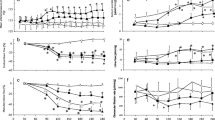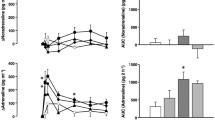Summary
Based on previous studies we postulated that, whereas the natriuresis observed following intracerebroventricular (i.c.v.) moxonidine was mediated by a decrease in renal sympathetic nerve activity, the natriuresis observed following intrarenal (i.r.) infusion of moxonidine was mediated by a direct stimulation of renal I1-imidazoline preferring receptors. Sprague-Dawley rats were unilaterally nephrectomized and i.c.v. cannulated 7 to 10 days and 3 days prior to the day of the experiment, respectively. On the day of the experiment, rats were anesthetized (pentobarbital) and the renal function was isolated. Administration of i.c.v. as well as i.r. moxonidine produced an increase in sodium excretion and urine flow fate. Pretreatment with intravenous prazosin (0.15 mg/kg) completely attenuated the response to i.c.v. moxonidine (1 nmol/5 µl) but only slightly altered the response to i.r. moxonidine (3 nmol/kg/min). Conversely, intravenous pretreatment with the imidazoline preferring receptor antagonist idazoxan (0.3 mg/kg) completely blocked the response to i.r. moxonidine (3 nmol/kg/min) without altering the response to i.c.v. moxonidine (0.3 nmol/kg). These results would be consistent with the natriuresis observed following i.c.v. moxonidine as being mediated by imidazoline preferring receptors located centrally, whereas that following i.r. moxonidine was mediated directly by renal imidazoline-preferring receptors, with a small component of this response conceivably due to activation of central imidazoline preferring receptors. In summary, the antihypertensive effect of imidazoline preferring receptor agonists may be associated with a natriuresis that is due to stimulation of these receptors, found both peripherally (renal) and centrally.
Similar content being viewed by others
References
Ernsberger P. Heterogeneity of imidazoline binding sites: Proposed I1 and I2 subtypes (abstr).Fundam Clin Pharmacol 1992;6(Suppl 1):55s.
Michel MC, Ernsberger P. Keep an eye on the I-site: Imidazoline preferring receptors.Trends Pharmacol Sci 1992;13:369.
Reis DJ, Regunathan S, Wang H, Feinstein DL, Meely MP. Imidazoline receptors in the nervous system.Fundam Clin Pharmacol 1992;6(Suppl 1):23S-27S.
Tibiriça E, Feldman J, Mermet C, Gonon F, Bousquet P. An imidazoline-specific mechanism for the hypotensive effect of clonidine: A study with yohimbine and idazoxan.J Pharmacol Exp Ther 1991;256:606–613.
Gomez RE, Ernsberger P, Feinland G, Reis DJ. Rilmenidine lowers arterial blood pressure via imidazole receptors in brain stem C1 area.Eur J Pharmacol 1991;195:181–191.
Ernsberger P, Westbrooks KL, Christen MO, Schäfer SG. A second generation of centrally acting antihypertensive agents act on putative I1-imadazoline receptors.J Cardiovasc Pharmacol 1992;20(Suppl 4):S1-S7.
Ernsberger P, Damon HD, Graff LM, Schäfer SG, Christen MO. Moxonidine a centrally acting antihypertensive agent is a selective ligand for I1-imadazoline sites.J Pharmacol Exp Ther 1993;264:172–177.
Penner SB, Smyth DD. Renal function following central administration of two unique imidazoline preferring agonists.Clin Invest Med 1992;15:A68.
Allan DR, Penner SB, Smyth, DD. Renal imidazoline preferring sites and solute excretion in the rat.Br J Pharmacol 1993;108:870–875.
Blandford DE, Smyth DD. Dose selective dissociation of water and solute excretion after alpha-2 adrenoceptor stimulation.J Pharmacol Exp Ther 1988;247:1181–1186.
Blandford DE, Smyth DD. Role of vasopressin in response to intrarenal infusions of alpha-2 adrenoceptor agonists.J Pharmacol Exp Ther 1990;255:264–270.
Penner SB, Smyth DD, Glavin GB. Decreased gastric acid output following neuropeptide Y administration into the lateral cerebral ventricle of conscious rats. Ann NY Acad Sci 1990;597:43–50.
Winer BJ. Statistical Principles in Experimental Design, 2nd ed. New York: McGraw-Hill, 1971.
Tibiriça E, Mermet C, Feldman J, Gonon F, Bousquet P. Correlation between the inhibitory effect of catecholaminergic ventrolateral medullary neurons and the hypotension evoked by clonidine: A voltammetric approach.J Pharmacol Exp Ther 1989;250:642–647.
Tibiriça E, Feldman J, Bousquet P. Contribution of catecholaminergic neurons of the dorsomedial and ventrolateral medulla oblongata to the hypotensive effect of clonidine in spontaneously hypertensive rats: In vivo voltammetric studies.J Hypertens 1992;10:1327–1334.
Kopp UC, DiBona GF. The neural control of renal function. In: Seldin DW, Giebisch G, ed.The Kidney—Physiology and Pathophysiology. New York: Raven Press 1992;1157–1204.
Koepke JP, Jones S, DiBona GF. Alpha-2 adrenoceptors in amygdala control renal sympathetic nerve activity and renal function in conscious spontaneously hypertensive rats.Brain Res 1987;404:80–88.
Bidet M, Poujeol P, Parini A. Effect of imidazolines on Na+ transport and intracellular pH in renal proximal tubule cells.Biochim Biophys Acta 1990;1024:173–178.
Smyth DD, Umemura S, Pettinger WA. Renal nerve stimulation causes α1 adrenoceptor mediated sodium retention but not α2 adrenoceptor antagonism of vasopressin.Circ Res 1985;57:304–311.
Author information
Authors and Affiliations
Additional information
Supported by the Heart and Stroke Foundation of Canada (SBP) and the Medical Research Council of Canada (DDS).
Rights and permissions
About this article
Cite this article
Penner, S.B., Smyth, D.D. Central and renal I1 imidazoline preferring receptors: Two unique sites mediating natriuresis in the rat. Cardiovasc Drug Ther 8 (Suppl 1), 43–48 (1994). https://doi.org/10.1007/BF00877083
Issue Date:
DOI: https://doi.org/10.1007/BF00877083




